 |
 |
 |
| |
Steady-state pharmacokinetic parameters of nevirapine extended release formulation tablets in children with HIV-1 infection: an open-label, multiple-dose, cross-over study
|
| |
| |
Reported by Jules Levin
18th CROI Congress Feb 27th - Mar 7th 2011, Boston, USA
CARLO GIAQUINTO1, GABRIEL ANABWANI2, CORNELIA FEITERNA-SPERLING3, JAMES NUTTALL4, KGOSIDIALWA MOMPATI5, FEDERICO MENSA6, CHAN-LOI YONG6, JOHN P SABO6, JUNHAI GUO6, ANNE-MARIE QUINSON6
Affiliations: 1 Department of Pediatrics, University of Padua, Italy; 2 Botswana Baylor Children Centre of Excellence, Gaborone, Botswana; 3 Charite-Universitatsmedizin Berlin, Germany; 4 Red Cross Children's Hospital, Cape Town, South Africa; 5 Tati River Clinic, Francistown, Botswana; 6 Boehringer Ingelheim Pharmaceuticals, Inc, Ridgefield, CT, USA
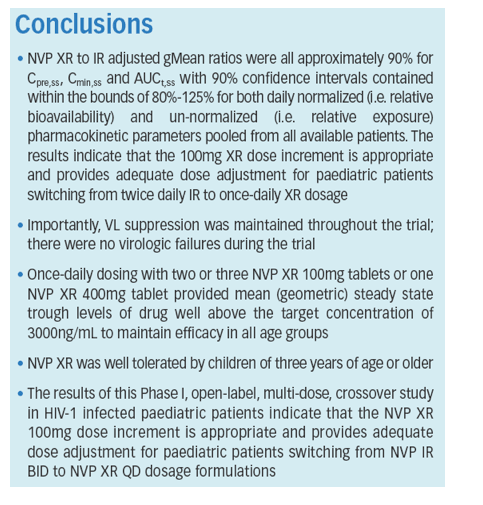
Abstract
Background: Extended release (XR) formulations of the available immediate-release nevirapine (NVP IR, Viramune®) 200mg twice-daily (BID) have been developed to allow once-daily (QD) dosing, which may improve treatment convenience and adherence, while maintaining the predicted target steady state (ss) mean trough NVP plasma concentration (Cpre,ss) around 3,000ng/mL. This study assessed the ss pharmacokinetics (PK) of varying daily doses of a single NVP XR 100mg tablet or one NVP XR 400mg tablet QD compared with NVP IR BID in HIV-1 infected children.
Methods: A Phase I, open-label, multi-dose, cross-over study in 85 patients aged S3-<18 years, previously treated for S18 weeks with a NVP IR-based regimen and viral load <50 copies/mL at baseline. Patients were stratified by age group (3-<6; 6-<12; 12-<18 years) and switched to NVP XR based on the NVP IR dose calculated by body weight or body surface area (BSA).
NVP XR daily doses were 200mg, 300mg (as multiple 100mg tablets) or 400mg (as 1 x 400mg tablet). Patients were treated with NVP IR BID (tablets or suspension) for 11 days, then NVP XR for 10 days. Cpre,ss was obtained from all patients, while ss 12-h and 24-h PK profiles were obtained for NVP IR and NVP XR, respectively, for patients enrolled in the PK sub-study. Viral suppression was monitored and adverse events (AEs) recorded.
Results: Eighty out of 85 participants (94.1%) completed the trial. Seventy-four
had Cpre,ss and 45 had intensive PK data available for analysis. The adjusted geometric mean (gMean) Cpre,ss values for NVP XR and NVP IR (4,149.05 and 4,518.24 ng/mL respectively) exceeded the target Cpre,ss. The adjusted gMean NVP XR:NVP IR ratios for daily dose normalized (ng/mL per mg per day) and un-normalized Cpre,ss were 91.20% (90% CI 83.47-99.64%) and 91.83% (90% CI 83.74-100.69%), respectively, both with 90% CI within the bounds of 80%-125%.
Adjusted gMean 24-h area under curve (AUCt,ss) NVP XR:NVP IR ratio for un-normalized dose was 90.39% (90% CI 82.39- 99.17%). Un-normalized Cpre,ss NVP XR:NVP IR ratios were 91.01%, 81.87% and 103.73%, for the 3-<6; 6-<12; 12-<18 year age groups, respectively.
Viral suppression was maintained for each age group during the study period. Incidence of any AEs (including infections/infestations, skin/subcutaneous, and respiratory) was 47% with NVP XR and 28.2% with NVP IR, mainly of mild intensity and similar between age groups. No AEs of DAIDS Grade 4, serious AEs or treatment discontinuations due to AEs occurred.
Conclusions: QD dosing with NVP XR exhibited PK profiles that provided adequate Cpre,ss, with bioavailability for NVP XR relative to NVP IR BID within
the accepted range of bioequivalence. NVP XR was well tolerated in paediatric patients.
Introduction
Nevirapine (NVP), a non-nucleoside reverse transcriptase inhibitor (NNRTI) for the treatment of HIV-1 in children and adults, has been available as an immediate release (IR) twice-daily (BID) dose formulation in tablets and oral suspension since 1996
Adherence to antiretroviral regimens is a major predictor of virological response and is fundamental to successful treatment, especially in children [1]
Data from published clinical studies have shown that once-daily (QD) dosing regimens improve treatment adherence compared with twice-daily (BID) dosing regimens [2, 3]
Liquid formulations used to treat infants and children may have the disadvantage of poor palatability, large dose volume, and frequent dosing requirements. Thus, the WHO recommends that children be switched to solid formulations as soon as possible or tolerable, and strongly supports the development of solid dose formulations that can be used by paediatric patients under 14 Kg weight [5]
In this context, an extended release formulation of NVP (NVP XR) has been developed to allow QD dosing, which is likely to improve adherence and in turn, may help improve treatment response and limit the development of drug-resistance. Children receiving tablets of NVP IR QD may benefit from switching to once-daily NVP XR; likewise, children receiving NVP IR suspension BID may benefit from switching to a solid formulation of NVP XR tablets QD with an appropriate paediatric dosing
The efficacy and safety of NVP XR QD has been examined in HIV-1-infected
treatment-naïve adults and shown to be non-inferior to NVP IR BID [4]
The aim of this study was to compare and validate NVP XR QD 100mg and 400mg tablets with the standard NVP IR either as 200mg BID tablet or BID oral suspension formulations in the paediatric population, in terms of steady state (ss) pharmacokinetic (PK) targets
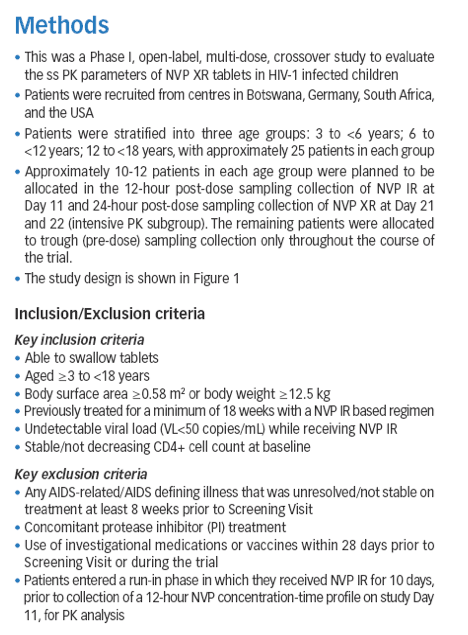
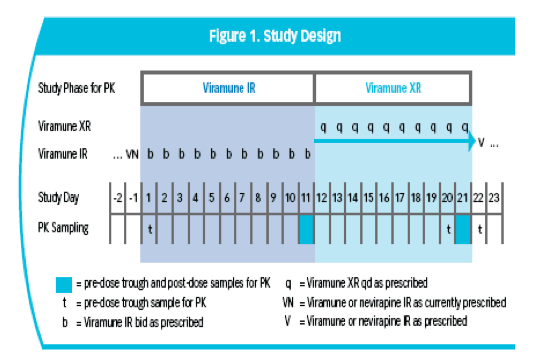
On Day 11, a 12-hour concentration-time PK profile for NVP IR was assessed in plasma with nominal sample collection times at 0 (pre-dose), 2, 4, 8 and 12 hours relative to the dose administrated in the morning on Day 11
On Day 12, NVP IR was switched to NVP XR and all patients received this formulation prior to collection of a 24-hour NVP concentration-time profile on study Days 21 and 22, for PK analysis.
On Day 21 and 22, a 24-hour concentration-time PK profile of NVP XR was assessed in plasma with nominal sample collection times at 0 (predose), 2, 4, 8, 12 and 24 hours (Day 22) relative to the dose administrated in the morning at Day 11.
When switched to the NVP XR formulation, patients were treated with NVP XR 200mg (2 tablets of 100mg), 300mg (3 tablets of 100mg), or 400mg (1 tablet of 400mg), based on their previous NVP IR dose calculated either by body surface area or body weight
Nevirapine XR dosing was based on the NVP IR dose received on Day 1 as follows: 175-249mg/day of IR was 200mg/day XR equivalent, 250-349mg/day of IR was 300mg/day XR equivalent and S350mg/day of IR was 400mg/day XR equivalent
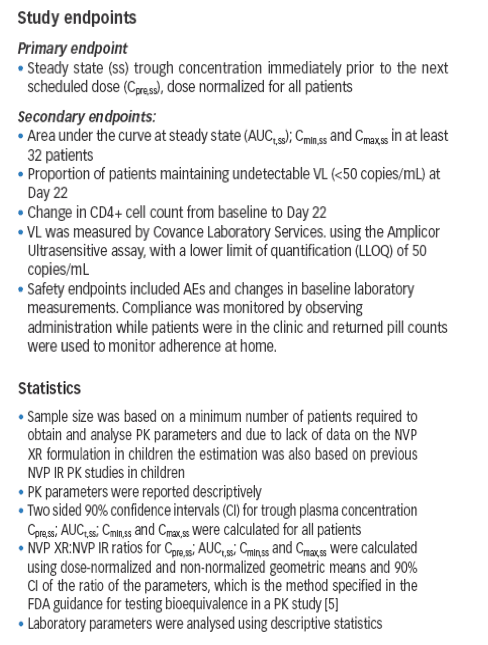
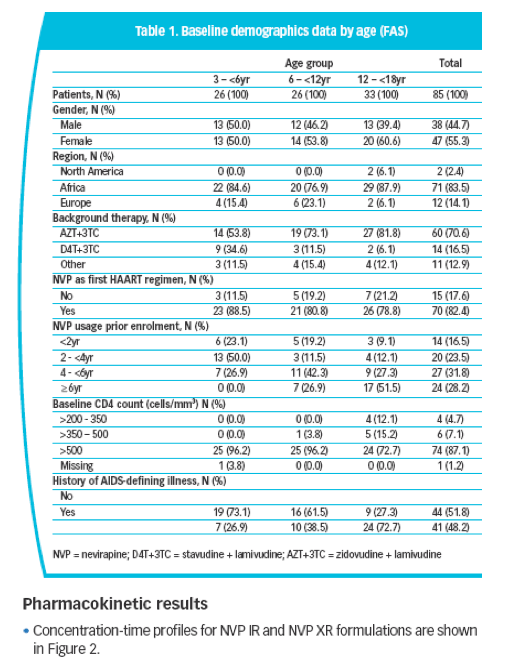
Results
Patient disposition and demographics
Baseline demographic data and disposition by age group (full analysis set [FAS]) are shown in Table 1
A total of 90 patients were enrolled, of whom five failed to meet screening requirements and 85 were allocated to the three age groups (Table 1)
Five patients (5.9%) prematurely discontinued trial medication (two were not compliant with the protocol and three for reasons unrelated to medication formulation or tolerability)
In total, 80 (94.1%) children completed the trial up to visit 7 (Day 22)
Two patients violated treatment protocol (received an inappropriate NVP daily dose) and were excluded from the PK analysis set (n=83)
All 85 patients were included in the safety and efficacy analysis, forming the FAS
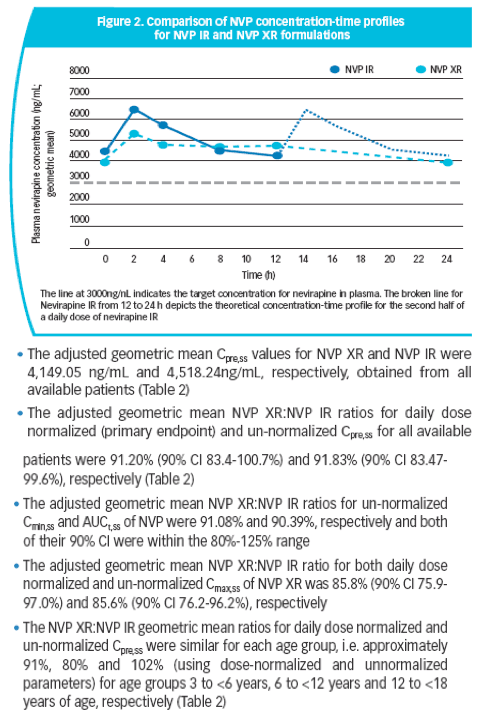
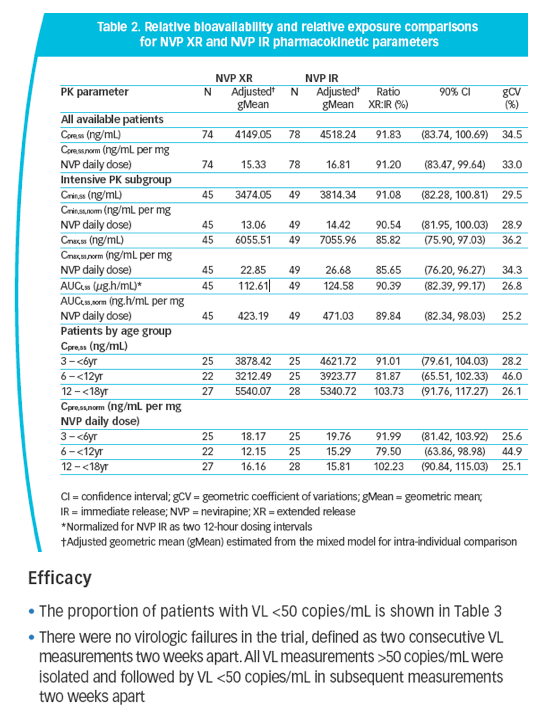
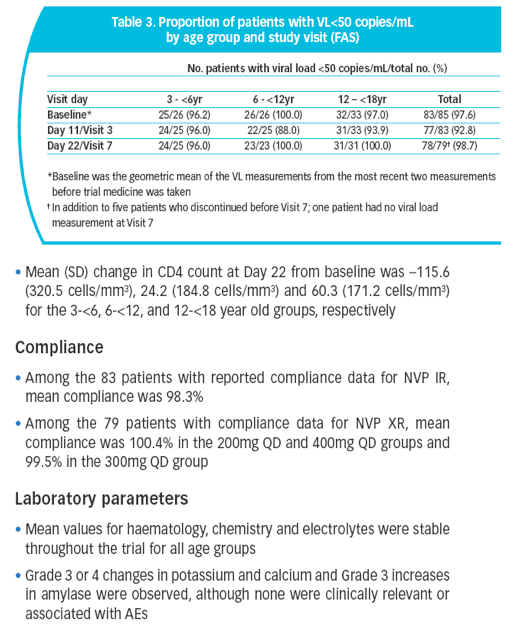
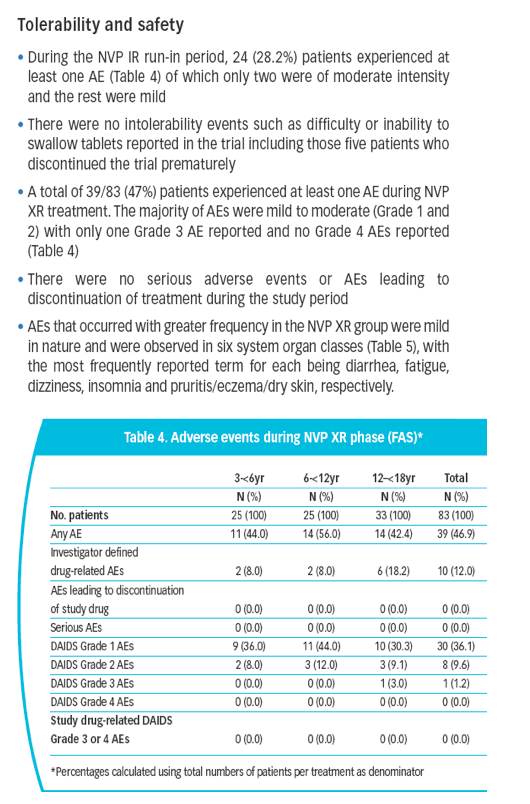
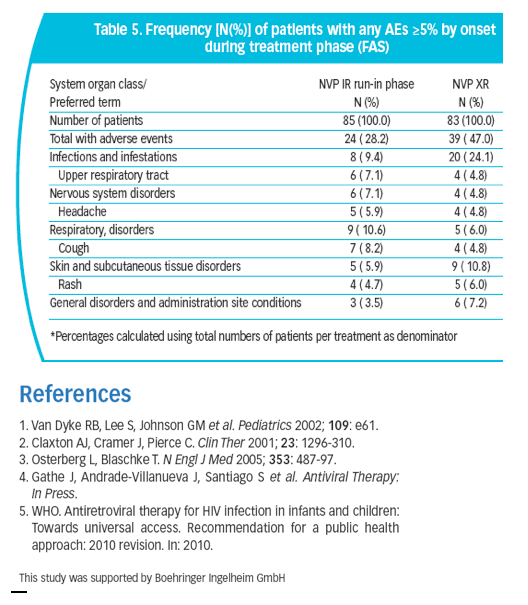
|
| |
|
 |
 |
|
|